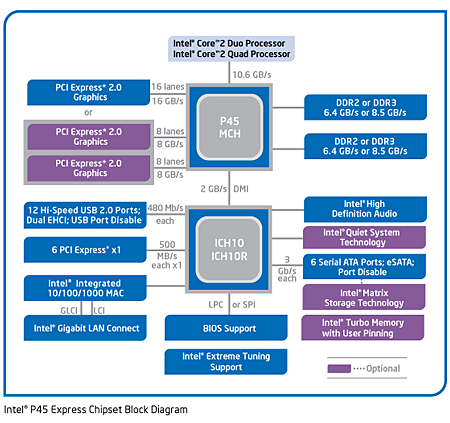11-Way P45 Motherboard Shootout
Introduction
When Intel released its mainstream P45 Express chipset, the biggest news was that it supported PCI Express 2.0. Formerly available from Intel only on high-end X38 and X48 motherboards, many of us still failed to understand the significance of this bandwidth-doubling technology to current-generation hardware. After all, the first-generation x16 slots found on P35 Express motherboards are still fast enough for any graphics card, so why bother updating ?
In order to truly understand how important PCI Express 2.0 is to the (upper) mainstream gaming market, one has to consider the P45 Express northbridge’s other key feature : its ability to split those sixteen lanes into two x8 pathways.
The ability to run two PCI Express graphics cards in x8 mode hasn’t been available from Intel since the days of its 975X chipset. Dual-graphics P965 and P35 motherboards usually relied on x4 pathways for the second slot, starving the second card with a lowly 2 GB/s transfer rate. By allowing its 16 PCI Express pathways to be divided into two x8-mode slots, the P45 Express can now deliver the same 8 GB/s bandwidth to two graphics cards that its P35 predecessor could deliver to only one.
Other updates to the P45 Express technology, such as the ability to support a total of 16GB RAM rather than the 8GB of the P35 Express, are far less significant to the majority of its mainstream/performance market. In fact, those who would never even consider using Crossfire technology might prefer to save some money by purchasing a less-expensive P35 motherboard, as implied in our earlier P45 Express technology overview
Given that the P45 Express’ major features target gaming enthusiasts, it comes as no surprise that many manufacturers have chosen this mainstream part as the basis for reduced-cost, high-end products. Others have chosen to use only a minimum number of high-end features to bring added value to the budget/performance market. Today’s eleven motherboards represent that range of products bound by these philosophies.
Get Tom's Hardware's best news and in-depth reviews, straight to your inbox.
-
nickchalk Where are the lower price P45 M/B ?Reply
Asus P5Q pro is out for €110 and P5Q deluxe for €165 the price difference is about 70$ in Greece. -
Proximon I suppose I can get some good from having read this. Did you get paid by the word? Maybe next time you could just put together a complete features chart so that we can have some convenient comparison? You know, so someone could go to a chart and see at a glance which boards had eSATA or firewire, or 8 USB.Reply
-
JPForums I'd rather have the overabundance of information than a lack of information. Presentation could use a little refining (I.E. comparison charts and the likes), but having the relevant information available at least is a good thing.Reply -
the introduction and specifics are nice, the comparision isn't. so, why don't you test with an 8500 or qx9650? 6850 are outdated... and a mobo handling a c2d doesn't mean it can handle a quad too, see P5K for example (it stinks when it comes to a q6600).Reply
-
Crashman procithe introduction and specifics are nice, the comparision isn't. so, why don't you test with an 8500 or qx9650? 6850 are outdated... and a mobo handling a c2d doesn't mean it can handle a quad too, see P5K for example (it stinks when it comes to a q6600).Reply
Tom's Hardware wants the performance of current articles to reflect that of recent articles, so a "standard test platform" was chosen a while ago. It will get updated, but probably not before the new socket becomes widely available. -
zenmaster I would have liked to see something such as a P35 and an X48 as controls to help analyze the P45 Performance.Reply
In otherwords, What is the P45 Gaining me over the older P35.
What would I gain by going to the X48. (Or Lose) -
Crashman zenmasterI would have liked to see something such as a P35 and an X48 as controls to help analyze the P45 Performance.In otherwords, What is the P45 Gaining me over the older P35.What would I gain by going to the X48. (Or Lose)http://www.tomshardware.com/reviews/intel-p45-chipset,1961.htmlReply -
johnbilicki The first 17 pages were filled with nothing but junk from ASUS. Do us a favor: don't even bother featuring or *MENTIONING* anything for any reason from a company that refuses to RMA 200-400 dollar brand new motherboards with anything other then used and usually broken junk. It destroyed my enthusiasm for the article.Reply -
dobby nickchalkWhere are the lower price P45 M/B ?Asus P5Q pro is out for €110 and P5Q deluxe for €165 the price difference is about 70$ in Greece.Reply
the p5q PRo is a p43 board, i should know i have one

